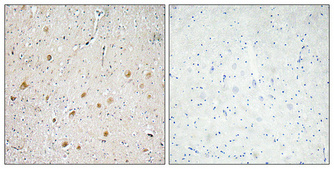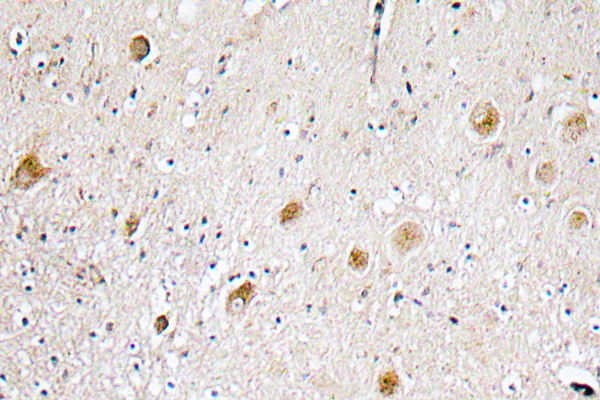FGF-1 Polyclonal Antibody
- Catalog No.:YT1695
- Applications:IHC;IF;ELISA
- Reactivity:Human;Mouse;Rat
- Target:
- FGF-1
- Fields:
- >>MAPK signaling pathway;>>Ras signaling pathway;>>Rap1 signaling pathway;>>Calcium signaling pathway;>>PI3K-Akt signaling pathway;>>Hippo signaling pathway;>>Regulation of actin cytoskeleton;>>Pathways in cancer;>>Melanoma;>>Breast cancer;>>Gastric cancer
- Gene Name:
- FGF1
- Protein Name:
- Fibroblast growth factor 1
- Human Gene Id:
- 2246
- Human Swiss Prot No:
- P05230
- Mouse Gene Id:
- 14164
- Mouse Swiss Prot No:
- P61148
- Rat Gene Id:
- 25317
- Rat Swiss Prot No:
- P61149
- Immunogen:
- The antiserum was produced against synthesized peptide derived from human FGF-1. AA range:7-56
- Specificity:
- FGF-1 Polyclonal Antibody detects endogenous levels of FGF-1 protein.
- Formulation:
- Liquid in PBS containing 50% glycerol, 0.5% BSA and 0.02% sodium azide.
- Source:
- Polyclonal, Rabbit,IgG
- Dilution:
- IHC 1:100 - 1:300. ELISA: 1:10000.. IF 1:50-200
- Purification:
- The antibody was affinity-purified from rabbit antiserum by affinity-chromatography using epitope-specific immunogen.
- Concentration:
- 1 mg/ml
- Storage Stability:
- -15°C to -25°C/1 year(Do not lower than -25°C)
- Other Name:
- FGF1;FGFA;Fibroblast growth factor 1;FGF-1;Acidic fibroblast growth factor;aFGF;Endothelial cell growth factor;ECGF;Heparin-binding growth factor 1;HBGF-1
- Molecular Weight(Da):
- 17kD
- Background:
- The protein encoded by this gene is a member of the fibroblast growth factor (FGF) family. FGF family members possess broad mitogenic and cell survival activities, and are involved in a variety of biological processes, including embryonic development, cell growth, morphogenesis, tissue repair, tumor growth and invasion. This protein functions as a modifier of endothelial cell migration and proliferation, as well as an angiogenic factor. It acts as a mitogen for a variety of mesoderm- and neuroectoderm-derived cells in vitro, thus is thought to be involved in organogenesis. Multiple alternatively spliced variants encoding different isoforms have been described. [provided by RefSeq, Jan 2009],
- Function:
- function:The heparin-binding growth factors are angiogenic agents in vivo and are potent mitogens for a variety of cell types in vitro. There are differences in the tissue distribution and concentration of these 2 growth factors.,miscellaneous:This protein binds heparin, although less strongly than does bFGF.,similarity:Belongs to the heparin-binding growth factors family.,subunit:Monomer. Binds FGFR2. Forms a ternary complex containing 2 molecules each of FGFR2 and FGF1 for 1 heparin molecule. Found in a complex with FGFBP1, FGF1 and FGF2. Interacts with FGFBP1.,
- Subcellular Location:
- Secreted. Cytoplasm. Cytoplasm, cell cortex. Cytoplasm, cytosol. Nucleus. Lacks a cleavable signal sequence. Within the cytoplasm, it is transported to the cell membrane and then secreted by a non-classical pathway that requires Cu(2+) ions and S100A13. Secreted in a complex with SYT1 (By similarity). Binding of exogenous FGF1 to FGFR facilitates endocytosis followed by translocation of FGF1 across endosomal membrane into the cytosol. Nuclear import from the cytosol requires the classical nuclear import machinery, involving proteins KPNA1 and KPNB1, as well as LRRC59. .
- Expression:
- Predominantly expressed in kidney and brain. Detected at much lower levels in heart and skeletal muscle.
- June 19-2018
- WESTERN IMMUNOBLOTTING PROTOCOL
- June 19-2018
- IMMUNOHISTOCHEMISTRY-PARAFFIN PROTOCOL
- June 19-2018
- IMMUNOFLUORESCENCE PROTOCOL
- September 08-2020
- FLOW-CYTOMEYRT-PROTOCOL
- May 20-2022
- Cell-Based ELISA│解您多样本WB检测之困扰
- July 13-2018
- CELL-BASED-ELISA-PROTOCOL-FOR-ACETYL-PROTEIN
- July 13-2018
- CELL-BASED-ELISA-PROTOCOL-FOR-PHOSPHO-PROTEIN
- July 13-2018
- Antibody-FAQs
- Products Images

- Immunohistochemical analysis of paraffin-embedded Human brain. Antibody was diluted at 1:100(4° overnight). High-pressure and temperature Tris-EDTA,pH8.0 was used for antigen retrieval. Negetive contrl (right) obtaned from antibody was pre-absorbed by immunogen peptide.

- Immunohistochemistry analysis of FGF-1 antibody in paraffin-embedded human brain tissue.



